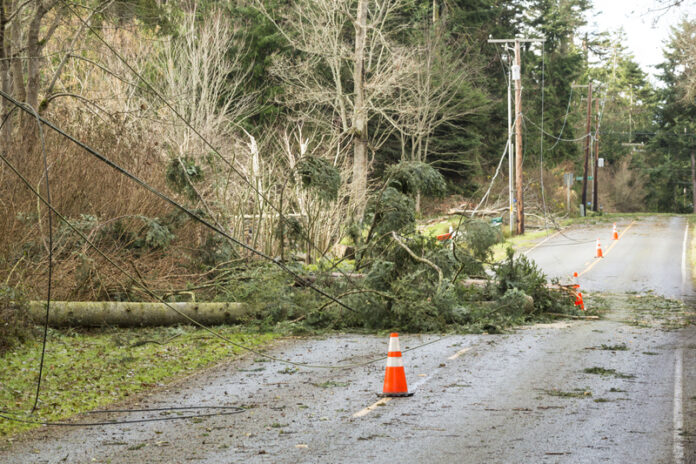Please welcome back Jane Marsh who has chosen a topic with which I have a personal connection. It was December 20, 2013, and my wife and I were living in a mid-town, ground-floor apartment when an ice storm hit Toronto. Although we were on a main street, our area was heavily forested. Electrical infrastructure was largely above-ground. Ice-encased tree limbs fell everywhere taking wires with them. It was more than five days before power returned to our unit. Without any heat, the pipes in our walls froze and when they finally thawed they burst flooding our unit.
Jane asks the question “Should the U.S. power grid move underground?” I would suggest this question be asked in all jurisdictions where weather events can lead to power failures.
A good example is PG&E, the California utility, whose above-ground electrical distribution system was the spark that caused a massive forest fire in the state.
Toppled utility poles and splayed power lines are unfortunately common, starting fires and damaging homes. In the United States, federal and state governments today are working to modernize the grid in conjunction with utility companies and urban design experts. Making electricity transmission more resilient and robust is a priority with a focus on withstanding natural disasters. Volatile climate activity makes many question if the grid would be safer underground. So does the rise in security threats.
Cybersecurity Defenses
Cybercriminals target critical power infrastructure. The U.S. Department of Energy (DoE) has realized this having been recently compromised by online criminal acts against the grid. As a result, the DoE has invested $34 million in moving grid technology in 11 states to below-ground. Doing this is one way to block vandals from physically interrupting power delivery.
To stop cybercriminals requires improved monitoring and running of the power grid because underground power infrastructure is not impenetrable to software hacks. Existing legacy systems need upgrades with active defence, widely deployed sensors, and reporting software. Threats may still come from physically digging below ground to try and interrupt the power, but with detection technologies grid operators can receive 24/7 alerts and know where a perpetrator is operating.
Home Electrification Trends
Households continue to increase the number of electric devices they use. Heat pumps and EV chargers only function if the electricity is on. The grid demand of the 21st century calls for better management, solutions and a hardened infrastructure to handle the ever-increasing demand.
Another trend is consumers transitioning to cleaner energy sources. Households are looking for ways to access power when the grid goes down. Climate change is raising expectations that outages will increase, be more severe, and will cost more. Hence, they are seeking smart technology and off-grid supplementation while striving to achieve a low-carbon future.
Grid designers are equally seeking ways to democratize power distribution to make it more robust. A good first step in the redesign is to downsize the number of above-grid powerlines. The immediate benefit is seen as strengthening the reliability of delivery whether to homes or businesses.
Preservation of Natural Splendour
An unsuspecting transmission line often creeps into gorgeous nature photography or ruins the view of an expensive tourist attraction. Visual pollution disrupts skylines and scenic beauty. I know this seems like a menial motivator for moving the grid below ground, but it can have considerable positive effects.
Destroyed power lines do more than mess up a beautiful view. They contaminate oceans, pollute plains, erode hillsides with uprooted trees and can spark fires. The devastation that downed powerlines can cause includes displaced species and habitats potentially beyond repair. Environmental awareness and care increase when there are fewer overhead wires.
Tourists like it better, too. An environment without visible power is more desirable to visit or live in. Their removal can significantly increase property values and preserve the aesthetic of the landscape.
Eliminating Liability for Economic Advantage
In 2023, citizens of Hawaii suspected that their electric company was the reason for 111 wildfire-related deaths on Maui because it did not shut down power lines at the time of an extreme high-wind event. PG&E went through a civil trial for its exposed liability when wildfires broke out in California forests where downed powerlines sparked the fires that led to homes and lives lost. Similar lawsuits against utility providers have increased because of aging and neglected infrastructure.
If powerlines weren’t on poles but rather underground, the abovementioned disasters would likely have been avoidable. If the utility companies had the technology to execute shutdowns quickly, disasters like these would be far less likely. Moving power-delivery infrastructure below ground eliminates liability and lawsuits.
Are There Reasons to Stay Above Ground?
Most evidence points to underground technology as a way to harden the grid against extreme weather events. Are there reasons to justify why powerlines remain above ground? The strongest reason to remain above ground is ease of access. It takes specialized equipment to install and maintain powerlines below ground.
Earthquakes represent another concern when burying powerlines. Areas prone to these events may have to avoid below-ground power infrastructure and look at alternative technology to protect the grid. This is one of the issues that companies like PG&E in the past, have faced when considering burying the lines.
What Lies Beneath
Critical grid infrastructure is associated with towering, expansive transmission lines. Building underground in the 21st century, however, may be where utilities will move to in consideration of extreme weather events associated with climate change. When you build underground, no snow weighs down and breaks powerlines. No powerful wind gusts penetrate to where the wires and infrastructure lie buried. Even if a portion of the grid is below ground, it gives utilities better grid reliability and reduces their liability in the changing world of the 21st century.
















